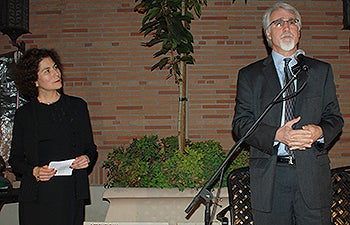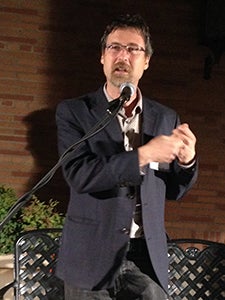‘We Are One People’
The man’s voice choked with emotion as he recounted how as a child, his family would gather each year on Aug. 14 to celebrate his birthday.
Until 1961, when everything changed.
On Aug. 13, his family heard on the news that the border between East and West Germany had been closed.
“The next day we got a phone call from my aunt saying, ‘We can’t come to visit, we can’t get across.’ So we drove to the border,” said the man who is speaking German in the 2011 documentary Behind the Wall. His family was now divided.
“That was very sad, to see how there was this border suddenly. There was nothing but barbed wire and we couldn’t cross anymore.”
The scene was one of many moving first-person accounts featured in the film, screened at USC’s University Park campus to commemorate the 25th anniversary of the fall of the Berlin Wall.
Organized by the USC German Studies Program, Behind the Wall documents what life was like on both sides of the wall as seen through the eyes of a diverse range of ordinary citizens from East and West Germany. The psychological impact of the Wall, the jubilation of November 1989, and its aftermath are explored, along with the positive and negative effects of reunification.
Projected onto the brick wall of the courtyard of LiteraTea, flickering black and white images showed East German border guards unrolling barbed wire, observed by solemn Berliners. These 1961 scenes and many more historical images from subsequent years were interspersed with contemporary footage, including eyewitness testimony.
Sponsored by the German Consulate, the USC Max Kade Institute for Austrian-German-Swiss Studies, and USC’s Feuchtwanger Memorial Library, the event featured opening remarks by Britta Bothe, associate professor (teaching) of German at USC Dornsife. It also included talks by Robert English, associate professor and director of international relations, and Cristina Cuevas-Wolf, resident historian at the Wende Museum in Los Angeles and a Max Kade Institute scholar.
Cuevas-Wolf showed artifacts from the museum, including a wedge-shaped, graffiti-sprayed chunk of the wall and an East German border guard’s cap.

The Berlin Wall caused suffering to the families and friends whom it kept apart for 28 years, Robert English said during the recent documentary screening, with historian Cristina Cuevas-Wolf also speaking at the event.
The documentary was followed by a question-and-answer session with English, Cuevas-Wolf, Bothe and Paul Lerner, associate professor of history and director of the Max Kade Institute.
“For the German people, the fall of the Berlin Wall spelled the end of this artificial division of their nation into two states,” English said. “It meant the end of travel restrictions that had divided friendships, families and even marriages. The Berlin Wall was a horrific aberration, a cruel barrier that caused great suffering.”
The most important milestone marking the end of the Cold War, the dominant geopolitical struggle of the late 20th century, the fall of the Berlin Wall has the power to inspire us today, English and Bothe noted.
“It marked the first major event in history where an entrenched conflict abruptly ended without tremendous bloodshed and loss of life,” Bothe said. “The involvement of individual citizens did count and ultimately helped bring about change.”
The wall was erected in the night of August 12-13, 1961, to isolate the postwar allied western sectors of the former German capital from Soviet occupied East Berlin. The barbed wire that formed the initial barrier was swiftly covered with bricks and mortar. It was later reinforced multiple times to become an impenetrable 12-foot high concrete wall, roughly 100 miles long.
Berliners were shocked when they woke up on the morning of Aug. 13. The relatively fluid border, which had allowed some 60,000 East Germans to commute daily to well-paying jobs in the West, to visit friends and loved ones, attend soccer matches and concerts, or go to the theatre, was gone. Whichever side of the border one had gone to sleep on Aug. 12 was where one was stuck for the next 28 years.
“Officially known in East Germany as the Anti-Fascist Protection Barrier, it was in fact meant, not to keep out Western spies and infiltrators, but to keep the citizens of East Germany in,” English said. From the end of World War II until the wall’s erection in 1961, some three and a half million East Germans had escaped to the West — about 20 percent of the East German population.
“After the wall’s construction, between 1961 and 1989, an additional 5,000 people attempted to escape the so-called ‘workers paradise’ in socialist East Germany, with at least 200 fatalities,” English said.

Paul Lerner, associate professor of German and director of the Max Kade Institute, answered questions after the event.
The fall of the Berlin Wall came as reform demands and mass protests quickly spread in response to Mikhail Gorbachev’s perestroika — the Soviet leader’s “restructuring” of the Soviet Union’s political and economic system to become more open.
“November 1989 is a tribute to both Ronald Reagan and Mikhail Gorbachev, the American and Soviet leaders, who had begun cutting arms, lowering tension and negotiating a few years previously,” English added.
“The chaotic decision to open the barriers and allow East Germans to flood west and the concerted decision of the Soviet leadership not to interfere or use military force to halt the exodus became the pivotal climatic turning point in the long Cold War’s final end.
“The joyous crowds chanting ‘We are one people’ celebrated not only the long hoped-for reunification of the German nation which subsequently has been largely successful, but also the even longer dreamed-of reconciliation of Russia with Europe and the West, a project that recent events have cast in doubt.”
However, initial joy became tinged with bittersweet nostalgia for many East Germans.
“After reunification, many Germans woke up to the sober reality of the complicated process of uniting two countries that had existed as separate entities for 28 years,” said Bothe.
In the documentary, many East Germans spoke of the loss of community after reunification and their previously unknown fear of unemployment. Some felt they were treated as second-class citizens by West Germans.
USC German Studies Club President Margaret “M. E.” Purnell, an international relations major with a German studies minor at USC Dornsife, said she was moved by the film.
“It was great to get some perspective on the positive aspects of East Germany, which we don’t hear so much about.”